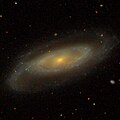NGC 5448 is a spiral galaxy in the constellation Ursa Major. The galaxy lies about 95 million light years away from Earth based on redshift-independent methods, which means, given its apparent dimensions, that NGC 5448 is approximately 120,000 light years across.[1] It was discovered by William Herschel on May 15, 1787.[3]
Characteristics
The galaxy has an elliptical bulge with boxy outer isophotes and an X-shape. A low-surface-brightness bar is seen running diagonally in the bulge.[4] Stellar kinematics indicate that there is a small stellar disk in the inner 7 arcseconds of the galaxy, which is inclined by about 13 degrees with the respect to the rest of the galaxy.[5] The stellar population in the centre of the galaxy is younger than that of the rest of the surrouding area.[6] In images by Hubble Space Telescope a prominent dust lane is visible in the circumnuclear region of the galaxy and three more diffuse a bit further away.[5]
Spiral arms emerge from the ends of the bar and wrap around forming a nearly complete ring. The arms are initially broad and high-contrast but after 45° degrees of revolution become narrow, while after completing a quarter of a revolution they start to branch. The galaxy has faint outer arms.[4] Many HII regions are visible in the inner arms, while knots are also visible in the outer arms.[7] Many dust lanes are visible across the disk.[5]
The nucleus of the galaxy has been found to be active and based on its emission lines has been identified as a type 2 LINER.[8] The most accepted theory for the energy source of active galactic nuclei is the presence of an accretion disk around a supermassive black hole. The mass of the black hole in the centre of NGC 5448 is estimated to be 107.3 (20 million) M☉ based on the absolute bulge magnitude.[9]
The galaxy is seen at high inclination viewed at an angle of 64°.[5]
Nearby galaxies
NGC 5448 is the foremost member of the NGC 5448 Group, also known as LGG 372. Other members of the group include NGC 5425, NGC 5480, NGC 5481, NGC 5520, NGC 5377, and NGC 5500.[10][11]
Gallery
-
NGC 5448 imaged by Sloan Digital Sky Survey
References
- ^ a b c d e f g h i "Results for object NGC 5448". NASA/IPAC Extragalactic Database. NASA and Caltech. Retrieved 25 February 2025.
- ^ a b "Revised NGC Data for NGC 5448". spider.seds.org. Retrieved 30 March 2024.
- ^ Seligman, Courtney. "NGC 5448 (= PGC 50031)". Celestial Atlas. Retrieved 19 November 2018.
- ^ a b Eskridge, Paul B.; Frogel, Jay A.; Pogge, Richard W.; Quillen, Alice C.; Berlind, Andreas A.; Davies, Roger L.; DePoy, D. L.; Gilbert, Karoline M.; Houdashelt, Mark L.; Kuchinski, Leslie E.; Ramirez, Solange V.; Sellgren, K.; Stutz, Amelia; Terndrup, Donald M.; Tiede, Glenn P. (November 2002). "Near-Infrared and Optical Morphology of Spiral Galaxies". The Astrophysical Journal Supplement Series. 143 (1): 73–111. arXiv:astro-ph/0206320. Bibcode:2002ApJS..143...73E. doi:10.1086/342340.
- ^ a b c d Fathi, K.; Van De Ven, G.; Peletier, R. F.; Emsellem, E.; Falcon-Barroso, J.; Cappellari, M.; De Zeeuw, T. (11 December 2005). "A bar signature and central disc in the gaseous and stellar velocity fields of NGC 5448". Monthly Notices of the Royal Astronomical Society. 364 (3): 773–782. arXiv:astro-ph/0509642. Bibcode:2005MNRAS.364..773F. doi:10.1111/j.1365-2966.2005.09648.x.
- ^ Peletier, R. F.; Falcon-Barroso, J.; Bacon, R.; Cappellari, M.; Davies, R. L.; De Zeeuw, P. T.; Emsellem, E.; Ganda, K.; Krajnovi, D.; Kuntschner, H.; McDermid, R. M.; Sarzi, M.; Van De Ven, G. (1 August 2007). "The SAURON project - XI. Stellar populations from absorption-line strength maps of 24 early-type spirals". Monthly Notices of the Royal Astronomical Society. 379 (2): 445–468. arXiv:0704.2839. Bibcode:2007MNRAS.379..445P. doi:10.1111/j.1365-2966.2007.11860.x.
- ^ Sandage, A., Bedke, J. (1994), The Carnegie Atlas of Galaxies. Volume I, Carnegie Institution of Washington
- ^ Ho, Luis C.; Filippenko, Alexei V.; Sargent, Wallace L. W. (October 1997). "A Search for Dwarf Seyfert Nuclei. III. Spectroscopic Parameters and Properties of the Host Galaxies". The Astrophysical Journal Supplement Series. 112 (2): 315–390. arXiv:astro-ph/9704107. Bibcode:1997ApJS..112..315H. doi:10.1086/313041.
- ^ Dong, X. Y.; De Robertis, M. M. (March 2006). "Low-Luminosity Active Galaxies and Their Central Black Holes". The Astronomical Journal. 131 (3): 1236–1252. arXiv:astro-ph/0510694. Bibcode:2006AJ....131.1236D. doi:10.1086/499334.
- ^ Makarov, Dmitry; Karachentsev, Igor (21 April 2011). "Galaxy groups and clouds in the local (z~ 0.01) Universe". Monthly Notices of the Royal Astronomical Society. 412 (4): 2498–2520. arXiv:1011.6277. Bibcode:2011MNRAS.412.2498M. doi:10.1111/j.1365-2966.2010.18071.x. S2CID 119194025. Retrieved 1 February 2025.
- ^ Garcia, A. M. (1 July 1993). "General study of group membership. II. Determination of nearby groups". Astronomy and Astrophysics Supplement Series. 100: 47–90. Bibcode:1993A&AS..100...47G. ISSN 0365-0138.
External links
- NGC 5448 on WikiSky: DSS2, SDSS, GALEX, IRAS, Hydrogen α, X-Ray, Astrophoto, Sky Map, Articles and images
- NGC 5448 on SIMBAD










You must be logged in to post a comment.